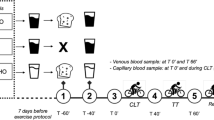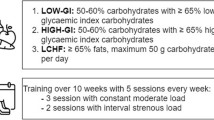Abstract
Purpose
This study investigated the impact of intensified training (IT) and carbohydrate (CHO) supplementation on resting and exercise-induced oxidative stress.
Methods
Male cyclists (n = 13, mean ± SD: age 25 ± 6 years; \(\dot{V}{\text{O}}_{2\hbox{max} }\) 72 ± 5 ml/kg/min) undertook two 9 day periods of endurance-based IT. In a counter-balanced, crossover and double-blinded study design, participants completed IT whilst ingesting high (H-CHO) or moderate (M-CHO) CHO beverages before (H-CHO: 24 g vs. M-CHO: 2 g), during (H-CHO: 60 g/h vs. M-CHO: 20 g/h) and after training sessions (H-CHO: 44 g vs. M-CHO: 10 g). Participants completed fasted performance trials without CHO on days 2, 6 and 10. Blood samples were taken before and immediately after exercise to assess plasma oxidative stress.
Results
Resting thiol (-SH) and catalase (CAT) activities decreased following 6 days of IT, independent of CHO condition [-SH (μM oxidised NADPH): H-CHO—14.0 ± 18.8, M-CHO—20.4 ± 20.3 and CAT (nmol/min/ml): H-CHO 12.5 ± 12.5, M-CHO 6.0 ± 4.5; all p < 0.05]. Resting total antioxidant capacity (TAC) was reduced after IT in M-CHO. All exercise bouts elicited significant increases in CAT, TAC, protein carbonylation (PC) and lipid hydroperoxides (LOOH), independent of CHO condition (p < 0.05). The magnitude of increase in PC and LOOH was greater on days 6 and 10 compared to day 2 in both conditions.
Conclusions
Short-term IT caused reductions in resting antioxidant capacity in trained cyclists. Exercise-induced increases in PC and LOOH were exaggerated as a result of IT; however, these responses were independent of carbohydrate intake before, during and after the preceding IT sessions.


Similar content being viewed by others
Abbreviations
- ANOVA:
-
Analysis of variance
- CAT:
-
Catalase activity
- M-CHO:
-
Moderate carbohydrate group
- CV:
-
Coefficient of variance
- DNA:
-
Deoxyribonucleic acid
- DNPH:
-
Dinitrophenylhydrazine
- ELISA:
-
Enzyme linked immunosorbent assay
- FRAP:
-
Ferric reducing ability of plasma
- H-CHO:
-
High carbohydrate group
- HCl:
-
Hydrochloric acid
- HRMAX :
-
Maximum heart rate
- HRP:
-
Horseradish peroxidase
- IT:
-
Intensified training
- LOOH:
-
Lipid hydroperoxides
- NaCl:
-
Sodium chloride
- NADH:
-
Reduced nicotinamide adenine dinucleotide
- OT:
-
Overtraining
- PC:
-
Protein carbonyl
- ROS:
-
Reactive oxygen species
- SD:
-
Standard deviation
- TAC:
-
Total antioxidant capacity
- TBS:
-
Tris-buffered saline
- -SH:
-
Total thiol activity
- VCO2 :
-
Carbon dioxide production
- VO2 :
-
Oxygen consumption
- VO2max :
-
Maximum oxygen consumption
References
Achten J, Halson SL, Moseley L, Rayson MP, Casey A, Jeukendrup AE (2004) Higher dietary carbohydrate content during intensified running training results in better maintenance of performance and mood state. J Appl Physiol 96(4):1331–40. http://www.ncbi.nlm.nih.gov/pubmed/14660506
Benzie IF, Strain JJ (1996) The ferric reducing ability of plasma (FRAP) as a measure of “antioxidant power”: the FRAP assay. Anal Biochem 239(1):70–6. http://www.ncbi.nlm.nih.gov/pubmed/8660627
Bloomer RJ, Davis PG, Consitt LA, Wideman L (2007) Plasma protein carbonyl response to increasing exercise duration in aerobically trained men and women. Int J Sports Med 28(1):21–25 (ISI 000243359800004)
Buss H, Chan TP, Sluis KB, Domigan NM, Winterbourn CC (1997) Protein carbonyl measurement by a sensitive ELISA method. Free Radic Biol Med 23(3):361–366 (ISI A1997XG67400002)
Cao G, Prior RL (1998) Comparison of different analytical methods for assessing total antioxidant capacity of human serum. Clin Chem 44(6 Pt 1):1309–15. http://www.ncbi.nlm.nih.gov/pubmed/9625058
Carty JL, Bevan R, Waller H et al (2000) The effects of vitamin C supplementation on protein oxidation in healthy volunteers. Biochem Biophys Res Commun 273(2):729–35. http://www.ncbi.nlm.nih.gov/pubmed/10873672
El-Saadani M, Esterbauer H, El-Sayed M, Goher M, Nassar AY, Jurgens G (1989) A spectrophotometric assay for lipid peroxides in serum lipoproteins using a commercially available reagent. J Lipid Res 30(4):627–30. http://www.ncbi.nlm.nih.gov/pubmed/2754343
Faul F, Erdfelder E, Lang AG, Buchner A (2007) G*Power 3: a flexible statistical power analysis program for the social, behavioral, and biomedical sciences. Behav Res Methods 39(2):175–91. http://www.ncbi.nlm.nih.gov/pubmed/17695343
Ferreira LF, Reid MB (2008) Muscle-derived ROS and thiol regulation in muscle fatigue. J Appl Physiol 104(3):853–60. http://www.ncbi.nlm.nih.gov/pubmed/18006866
Finaud J, Scislowski V, Lac G et al (2006) Antioxidant status and oxidative stress in professional rugby players: evolution throughout a season. Int J Sports Med 27(2):87–93. http://www.ncbi.nlm.nih.gov/pubmed/16475052
Gomez-Cabrera MC, Domenech E, Vina J (2008) Moderate exercise is an antioxidant: upregulation of antioxidant genes by training. Free Radic Biol Med 44(2):126–31. http://www.ncbi.nlm.nih.gov/pubmed/18191748
Grove JR (1992) Preliminary evidence for the reliability and validity of an abbreviated profile of mood states. Int J Sport Psychol 23(2):93–109
Halson SL, Lancaster GI, Achten J, Gleeson M, Jeukendrup AE (2004) Effects of carbohydrate supplementation on performance and carbohydrate oxidation after intensified cycling training. J Appl Physiol 97(4):1245–53. http://www.ncbi.nlm.nih.gov/pubmed/15155717
Howley ET, Bassett DR Jr, Welch HG (1995) Criteria for maximal oxygen uptake: a review and commentary. Med Sci Sport Exerc 27(9):1292–1301
Jeukendrup A (2014) A step towards personalized sports nutrition: carbohydrate intake during exercise. Sports Med 44(Suppl 1):S25–33. http://www.ncbi.nlm.nih.gov/pubmed/24791914
Ji LL (2008) Modulation of skeletal muscle antioxidant defense by exercise: Role of redox signaling. Free Radic Biol Med 44(2):142–52. http://www.ncbi.nlm.nih.gov/pubmed/18191750
Khassaf M, Child RB, McArdle A, Brodie DA, Esanu C, Jackson MJ (2001) Time course of responses of human skeletal muscle to oxidative stress induced by nondamaging exercise. J Appl Physiol 90(3):1031–5. http://www.ncbi.nlm.nih.gov/pubmed/11181616
Killer SC, Svendsen IS, Jeukendrup AE, Gleeson M (2014a) Evidence of disturbed sleep and mood state in well-trained athletes during short-term intensified training with and without a high carbohydrate nutritional intervention. Preparation
Killer SC, Svendsen IS, Randell RK, Carter JM, Jeukendrup AE, Gleeson M (2014b) The impact of 9 days of intensified training with a high carbohydrate feeding strategy on hormonal balance and immune function in trained. Med Sci Sport Exerc (in revision 2014)
Lamb GD, Westerblad H (2010) Acute effects of reactive oxygen and nitrogen species on the contractile function of skeletal muscle. J Physiol 2011(589):2119–2127
Lamprecht M, Greilberger JF, Schwaberger G, Hofmann P, Oettl K (2008) Single bouts of exercise affect albumin redox state and carbonyl groups on plasma protein of trained men in a workload-dependent manner. J Appl Physiol 104(6):1611–7. http://www.ncbi.nlm.nih.gov/pubmed/18420715
Margonis K, Fatouros IG, Jamurtas AZ et al (2007) Oxidative stress biomarkers responses to physical overtraining: implications for diagnosis. Free Radic Biol Med 43(6):901–10. http://www.ncbi.nlm.nih.gov/pubmed/17697935
Mariotti F, Simbelie KL, Makarios-lahham L, Laplaize B, Tome D, Even PC (2004) Acute ingestion of dietary proteins improves post-exercise liver glutathione in rats in a dose- dependent relationship with their cysteine content. J Nutr 134:128–131
McAnulty SR, McAnulty LS, Nieman DC et al (2003) Influence of carbohydrate ingestion on oxidative stress and plasma antioxidant potential following a 3 h run. Free Radic Res 37(8):835–40. http://informahealthcare.com/doi/abs/10.1080/1071576031000136559
McAnulty SR, McAnulty LS, Morrow JD et al (2005) Effect of daily fruit ingestion on angiotensin converting enzyme activity, blood pressure, and oxidative stress in chronic smokers. Free Radic Res 39(11):1241–8. http://www.ncbi.nlm.nih.gov/pubmed/16298751
McAnulty S, McAnulty L, Nieman D, Morrow J, Dumke C, Utter A (2007a) Carbohydrate effect: hormone and oxidative changes. Int J Sports Med 28:921–927
McAnulty SR, McAnulty LS, Morrow JD, Nieman DC, Owens JT, Carper CM (2007b) Influence of carbohydrate, intense exercise, and rest intervals on hormonal and oxidative changes. Int J Sport Nutr Exerc Metab 17:478–490
Ogonovszky H, Berkes I, Kumagai S et al (2005) The effects of moderate-, strenuous- and over-training on oxidative stress markers, DNA repair, and memory, in rat brain. Neurochem Int 46(8):635–40. http://linkinghub.elsevier.com/retrieve/pii/S0197018605000665
Ogonovszky H, Sasvári M, Dosek A et al (2005) The effects of moderate, strenuous, and overtraining on oxidative stress markers and DNA repair in rat liver. Can J Appl Physiol 30(2):186–95. http://www.ncbi.nlm.nih.gov/pubmed/15981787
Packer L (1997) Oxidants, antioxidant nutrients and the athlete. J Sport Sci 15(3):353–63. http://www.ncbi.nlm.nih.gov/pubmed/9232561
Palazzetti S, Richard M-J, Favier A, Margaritis I (2003) Overloaded training increases exercise-induced oxidative stress and damage. Can J Appl Physiol 28(4):588–604. http://www.ncbi.nlm.nih.gov/pubmed/12904636
Powers SK, Jackson MJ (2008) Exercise-induced oxidative stress: cellular mechanisms and impact on muscle force production. Physiol Rev 88(4):1243–76. http://www.pubmedcentral.nih.gov/articlerender.fcgi?artid=2909187&tool=pmcentrez&rendertype=abstract
Radak Z, Kaneko T, Tahara S et al (1999) The effect of exercise training on oxidative damage of lipids, proteins, and DNA in rat skeletal muscle: evidence for beneficial outcomes. Free Radic Biol Med 27(1-2):69–74. http://www.ncbi.nlm.nih.gov/pubmed/10443921
Radak Z, Chung HY, Goto S (2005) Exercise and hormesis: oxidative stress-related adaptation for successful aging. Biogerontology 6(1):71–5. http://www.ncbi.nlm.nih.gov/pubmed/15834665
Rodriguez NR, DiMarco NM, Langley S (2009) Nutrition and Athletic Performance. Med Sci Sport Exerc Joint Pos:709–31
Rushall BS (1990) A tool for measuring stress tolerance in elite athletes. J Appl Sport Psychol 2(1):51–66
Smith PK, Krohn RI, Hermanson GT et al (1985) Measurement of protein using bicinchoninic acid. Anal Biochem 150(1):76–85. http://www.ncbi.nlm.nih.gov/pubmed/3843705
Svendsen IS, Killer SC, Carter J, Randell RK, Jeukendrup AE, Gleeson M (2014) Effect of intensified training with two different carbohydrate nutritional interventions on immune function and markers of overreaching in highly trained cyclists. Preparation
Tanskanen M, Atalay M, Uusitalo A (2010) Altered oxidative stress in overtrained athletes. J Sports Sci 28(3):309–17. http://www.ncbi.nlm.nih.gov/pubmed/20077275
Tanskanen MM, Uusitalo AL, Kinnunen H, Häkkinen K, Kyröläinen H, Atalay M (2011) Association of military training with oxidative stress and overreaching. Med Sci Sports Exerc 43(8):1552–60. http://www.ncbi.nlm.nih.gov/pubmed/21266928
Turner JE, Bosch JA, Drayson MT, Aldred S (2013) Assessment of oxidative stress in lymphocytes with exercise. J Appl Physiol 111(1):206–11. http://www.ncbi.nlm.nih.gov/pubmed/21493722
Vasankari T, Kujala U, Sarna S, Ahotupa M (1998) Effects of ascorbic acid and carbohydrate ingestion on exercise induced oxidative stress. J Sports Med Phys Fit 38(4):281–5. http://europepmc.org/abstract/MED/9973769
Wadley AJ, Veldhuijzen van Zanten JJCS, Paine NJ, Drayson MT, Aldred S (2014a) Underlying inflammation has no impact on the oxidative stress response to acute mental stress. Brain Behav Immun. http://www.ncbi.nlm.nih.gov/pubmed/24675034
Wadley AJ, van Zanten JJCSV, Stavropoulos-Kalinoglou A et al (2014b) Three months of moderate-intensity exercise reduced plasma 3-nitrotyrosine in rheumatoid arthritis patients. Eur J Appl Physiol. http://www.ncbi.nlm.nih.gov/pubmed/24719046
Wadley AJ, Chen YW, Bennett SJ et al (2015) Monitoring changes in thioredoxin and over-oxidised peroxiredoxin in response to exercise in humans. Free Radic Res 49(3):290–298
Zoppi CC, Macedo DV (2008) Overreaching-induced oxidative stress, enhanced HSP72 expression, antioxidant and oxidative enzymes downregulation. Scand J Med Sci Sports 18(1):67–76. http://www.ncbi.nlm.nih.gov/pubmed/17346286
Acknowledgments
Professor Michael Gleeson, Dr. Sophie Killer and Ida Svendsen were involved in the conception and design of the investigation. This study formed part of a larger investigation that assessed parameters of hormonal balance and immune function (Killer et al. 2014b; Svendsen et al. 2014) and in addition, the quality of sleep during short-term intensified training was monitored (Killer et al. 2014a). Changes in resting and exercise-induced oxidative stress were retrospective analyses proposed by Dr. Alex Wadley. All data collection was carried out by Dr. Sophie Killer and Ida Svendsen. All laboratory and statistical analysis were performed by Dr. Alex Wadley. Drafting of the article was by Dr. Alex Wadley and editing of the final version was carried out by all authors. This work was partially funded by the Gatorade Sports Science Institute, a division of PepsiCo Inc. The views expressed in this manuscript are those of the authors and do not represent the position or policy of PepsiCo, Inc.
Conflict of interest
None of the authors declare a conflict of interest.
Author information
Authors and Affiliations
Corresponding author
Additional information
Communicated by Anni Vanhatalo.
All work was undertaken at Loughborough University, UK.
Rights and permissions
About this article
Cite this article
Wadley, A.J., Killer, S.C., Svendsen, I.S. et al. The impact of intensified training with a high or moderate carbohydrate feeding strategy on resting and exercise-induced oxidative stress. Eur J Appl Physiol 115, 1757–1767 (2015). https://doi.org/10.1007/s00421-015-3162-4
Received:
Accepted:
Published:
Issue Date:
DOI: https://doi.org/10.1007/s00421-015-3162-4




